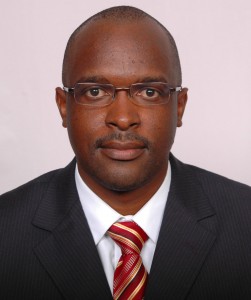IPNI: The right surce of nutrient, at the right time, at the right place
 In 2013, IPNI launched the 4R project to develop and promote best fertilizer management practices. The 4R concept appears simple: apply the right source of nutrient, at the right rate, at the right time and in the right place (detailed guidelines can be found in IPNI’s 4R Nutrient Stewardship Framework). Implementation, however, is both knowledge-intensive and site-specific.
In 2013, IPNI launched the 4R project to develop and promote best fertilizer management practices. The 4R concept appears simple: apply the right source of nutrient, at the right rate, at the right time and in the right place (detailed guidelines can be found in IPNI’s 4R Nutrient Stewardship Framework). Implementation, however, is both knowledge-intensive and site-specific.
The 4R pilot project site is in western Kenya, an area where, despite strong evidence of the potential to intensify maize productivity, farmers and extension agents lack information on how to do this. Working with farmers and the Ministry of Agriculture, the project is providing access to information through field-based learning centers, and demonstrating the importance of various nutrients – both macro and micronutrients – in the production of major crops. Gender-sensitive participatory approaches are used to ensure active participation and learning among women, who represent the majority of farmers involved. The pilot is also designed to generate 4R lessons that can be used and replicated across Eastern and Southern Africa.
Results from 30 field-based demonstration sites have highlighted the importance of site- specific fertilizer recommendations. On fertile fields that had received large additions of manure in the past, maize productivity of about 9 tons per hectare (t/ha) was achieved with the addition of nitrogen (N) and phosphorus (P)-based fertilizer. On infertile soils in the same locality, while application of N and P had limited effects of maize yields, substantial yield improvements were achieved with the addition of potassium (K). Despite the widespread deficiency of K, current fertilizer recommendations only cover N and P, and the 4R project is therefore supporting a revision of the fertilizer recommendations to address the need for K fertilizer.
More than 1,000 farmers, 30 extension agents and 60 agro-dealers were trained on best nutrient management practices in the first year of the project. In December 2013, around 50 agro-dealers from major towns in western Kenya’s Siaya County were trained on 4R nutrient management during a one-day workshop organized by IPNI and the Siaya County Department of Agriculture. The group was taken through an intensive and participatory presentation on the importance of applying the 4Rs for nutrient management. Data and photos from ongoing demonstration sites were used to illustrate each of the 4Rs and the need for balanced nutrition. During the training, staff from IPNI emphasized the important role that agro-dealers play in the agricultural value chain, as they form the main point of contact between farmers and the fertilizer industry. Agro-dealers were therefore urged to pass on the knowledge gained from the training to farmers during their day-to-day interactions.
The project is also developing extension material and using radio programs to communicate 4R information. In 2013, IPNI developed a series of products targeting various stakeholders, including policy makers, researchers and extension systems in Sub-Saharan Africa (SSA). Two videos outlining the challenges and opportunities surrounding the adoption of 4R Nutrient Stewardship were released, and are available on YouTube. The first highlights lessons being learned by the pilot project in western Kenya. In the second, Dr. Shamie Zingore, IPNI Director, SSA Program, discusses how the 4R Nutrient Stewardship concept can be adapted to smallholder farming systems. “The key role that appropriate fertilizer use can have on the overall performance of agriculture, and its ability to impact the food security balance, hinges on a simple yet knowledge intensive 4R strategy,” said Dr. Zingore. IPNI has also developed the 4R Plant Nutrient Management Manual and a series of extension pamphlets and posters for raising awareness of the need for good agronomic practices to improve crop productivity in the region.
To further support the efforts of farmers in targeting their use of fertilizer according to their specific soil conditions, IPNI has developed a simple computer-based decision support tool – Nutrient Expert® for Hybrid Maize (NE). Designed for use by researchers and extension agents, and already successfully adopted in India, Indonesia and the Philippines, a version for SSA has now been developed and validated in partnership with the MAIZE CRP. NE integrates data from multi-location nutrient omission trials to determine farm-specific fertilizer requirements, and takes account of the most important factors affecting nutrient management recommendations, including site characteristics, climate, input prices and crop produce prices.
The SSA version of Nutrient Expert® is also able to develop recommendations for high-, medium- and low-resource endowment farms, and has been updated to include net profit analysis and compare agronomic and economic performance of conventional and conservation agricultural systems. Thus, NE provides a tool to integrate socio-economic and agronomic information to guide targeting of nutrient management options to various farm types and fields. A new program has been launched to build the capacity of extension systems and farmers to apply the NE guidelines and test nutrient management options in a participatory process. This will support wider dissemination of site-specific nutrient management recommendations in maize-based smallholder farming systems.
Lastly, in February 2013, the IPNI SSA Program was awarded a three-year grant to provide technical support to the Soil Health Program of the Alliance for a Green Revolution in Africa (AGRA). IPNI is backstopping AGRA projects in eight countries to standardize protocols for implementation of agronomic trials and demonstrations and train researchers to effectively collect and analyze data from agronomic trials. IPNI is also supporting the development of nutrient management knowledge products to facilitate dissemination of best nutrient management practices in the region. The project has given IPNI a platform to play an influential role in regional efforts by AGRA and national research and extension systems to help smallholder farmers intensify crop production in a sustainable manner.
